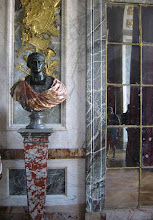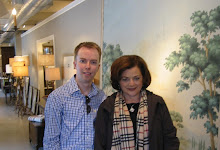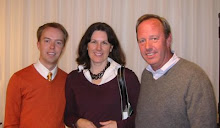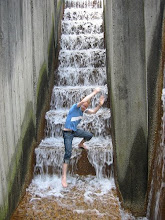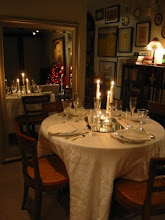 Sans souci is French for 'without cares or concerns'. It's also the name of a beautiful palace in Potsdam, outside of Berlin in Germany. It was sort of the Petit Trianon of Germany: it was built as a private refuge for the king. Designed in 1745 and later remodeled by successive kings, it remains a perfect example of the rococo style.
Sans souci is French for 'without cares or concerns'. It's also the name of a beautiful palace in Potsdam, outside of Berlin in Germany. It was sort of the Petit Trianon of Germany: it was built as a private refuge for the king. Designed in 1745 and later remodeled by successive kings, it remains a perfect example of the rococo style. 
 the front is built up on top of these terraces
the front is built up on top of these terraces detail of front caryatids
detail of front caryatids It's also the name of my 'good' china pattern by Rosenthal! I love this china because even though rosenthal has been making it for years, I have it in plain white. It's a great counterpart to the elaborate rococo tracery around the edge ( based on the main salon in Sanssouci) . A little modern ( white ) and a little old-fashioned -it's the Phillipe Starck of china patterns! Food also looks great against plain white porcelian. I'm sorry, no offense to anyone who has hot pink china with bright green polka dots. I'm sure thats beautiful too but nothing shows off food like pure white in my opinion. Plus if I didn't have this pattern in pure white it would look like someone's grandma's china!!

 service for 12
service for 12I visited Sans souci when I was a German exchange student in HS and remember being blown away. Both by the ornate palace itself but also by all the very unique buildings scattered around it and the beautiful gardens -such as this chinoiserie pavilion! 



 2 garden structures
2 garden structuresI think this was about the time I was seriously thinking of going to college to become an architect instead of music ( yes, even most of my close friend's don't know I used to be QUITE the piano player......i'm not anymore - practice makes perfect!! ). 

 view of rear of palace and view from the rear - the fake 'ruins' in the background are the waterpumps for the numerous fountains!
view of rear of palace and view from the rear - the fake 'ruins' in the background are the waterpumps for the numerous fountains! the orangery
the orangery








 About 225 pages are devoted to it - first a brief history, then site plan and floor plans (pictured ), some photos, detailed drawings of every room ( you could practically build it! ) and then some furniture working drawings of Marie Antoinette's furniture! The rear has a few envois drawings of students ( I'll do a posting on these drawings later ) and then some really interesting ads. You can find the book around through some antique vendors ( I did a quick froogle of it and found 2 up for sale on the WWW ).
About 225 pages are devoted to it - first a brief history, then site plan and floor plans (pictured ), some photos, detailed drawings of every room ( you could practically build it! ) and then some furniture working drawings of Marie Antoinette's furniture! The rear has a few envois drawings of students ( I'll do a posting on these drawings later ) and then some really interesting ads. You can find the book around through some antique vendors ( I did a quick froogle of it and found 2 up for sale on the WWW ). section, plan and elevation of stair hall
section, plan and elevation of stair hall a typical window detail and elevation - mirrored side panels!
a typical window detail and elevation - mirrored side panels! drawing showing the detailed flooring and paneling of the dining room
drawing showing the detailed flooring and paneling of the dining room detail of 'MA' monogram on paneling in stair hall
detail of 'MA' monogram on paneling in stair hall dressing table at Petit Trianon
dressing table at Petit Trianon section - on the right hand side of the lower one you see MA bedrooms off the salon with lower ceiling
section - on the right hand side of the lower one you see MA bedrooms off the salon with lower ceiling site plan of petit trianon ( square on the right side ), gardens and auxiliary buildings
site plan of petit trianon ( square on the right side ), gardens and auxiliary buildings

 When Louis XVI took over the throne when his grandfather died, he gave the jewel to his wife, Marie Antoinette in 1774. Marie used the petit trianon as a refuge from court life ( which she hated ) and to escape with her friends into a world of flowers and fun. Even her husband the king wasn't allowed except by invitation!
When Louis XVI took over the throne when his grandfather died, he gave the jewel to his wife, Marie Antoinette in 1774. Marie used the petit trianon as a refuge from court life ( which she hated ) and to escape with her friends into a world of flowers and fun. Even her husband the king wasn't allowed except by invitation! In the movie 'Marie Antoinette' (which you can read a bit about in my posting on the subject) you see Kirsten Dunst channeling Marie and having dinner parties with friends, roaming its gardens with her daughter and lounging with lovers in the secretive interiors ( she had mechanical mirrors installed as 'blinds' to keep people from peering inside ). The privacy was so intense that even servants couldn't observe her as the dining room table came up through a hole in the floor and they weren't required to serve the meal!
In the movie 'Marie Antoinette' (which you can read a bit about in my posting on the subject) you see Kirsten Dunst channeling Marie and having dinner parties with friends, roaming its gardens with her daughter and lounging with lovers in the secretive interiors ( she had mechanical mirrors installed as 'blinds' to keep people from peering inside ). The privacy was so intense that even servants couldn't observe her as the dining room table came up through a hole in the floor and they weren't required to serve the meal!





 the stair hall with lantern
the stair hall with lantern The bad copy -but nice landscaping
The bad copy -but nice landscaping  a garden pavilion on the grounds of the petit trianon
a garden pavilion on the grounds of the petit trianon

 the rear facade of the Elms
the rear facade of the Elms

 the fountain in the middle of the huge back lawn
the fountain in the middle of the huge back lawn


 here I am in front of one of the beautiful tea pavilions
here I am in front of one of the beautiful tea pavilions 











































.JPG)



























































